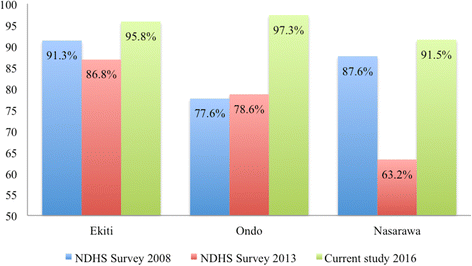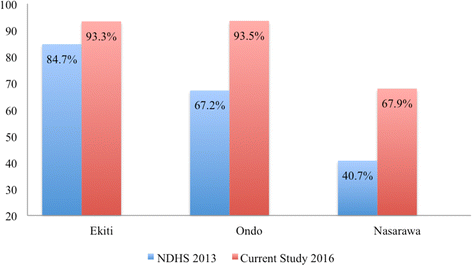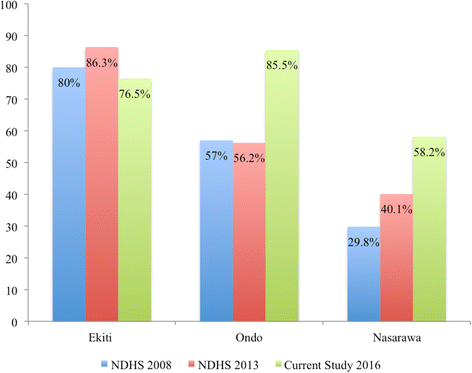Who benefits from free institutional delivery? evidence from a cross sectional survey of North Central and Southwestern Nigeria
- PMID: 28865462
- PMCID: PMC5581419
- DOI: 10.1186/s12913-017-2560-1
Who benefits from free institutional delivery? evidence from a cross sectional survey of North Central and Southwestern Nigeria
Abstract
Background: The reasons for low utilisation of maternal health services in settings where the user-fee removal policy has been implemented continue to generate scholarly debates. Evidence of whether user-fee removal benefits the poor women in underserved settings is scanty and inconsistent. This article examines use of maternal health care services in the context of free maternal healthcare and profiles the beneficiaries of user-fee removal.
Methods: The study adopted a descriptive design. A three-stage cluster sampling method was used to select a representative sample of 1227 women who gave birth between 2011 and 2015. Questionnaires were administered using a face-to-face interview approach and data generated were analysed using descriptive and inferential statistics.
Results: The analysis shows that the use of maternal healthcare services has improved considerably in North Central and Southwestern Nigeria. While socioeconomic and geographical inequality in the use of maternal healthcare services appear to be disappearing in Southwestern Nigeria, it appears to be widening in North Central Nigeria. The findings indicate that 33.6% of women reported to have benefitted from the free child-delivery programme; however, substantial variation exists across the two regions. The proportion of beneficiaries of user-fee removal policy was highest in urban areas (35.9%), among women belonging to the middle income category (38.3%), among women who gave birth in primary health centres (63.1%) and among women who resided in communities where there was availability of health facilities (37.2%).
Conclusion: The study concludes that low coverage of the free maternal health programme, especially among women of low socioeconomic status residing in underserved settings is among the reasons for persistent poor maternal health outcomes in the context of free maternal healthcare. A model towards improving maternal health in underserved settings, especially in North Central Nigeria, would entail provisioning of health facilities as well as focusing on implementing equitable maternal health policies.
Keywords: Free maternal health policy; Inequality; Maternal health; User-fee removal.
Conflict of interest statement
Ethics approval and consent to participate
The University of Fort Hare’s Research Ethic Committee (UREC) approved the study protocol (AKP031SAJA01). Written consent to participate was obtained from all study participants after explaining the aim of the study, and they alluded to understanding the aim of the study. The study was conducted by respecting the right of participants to privacy, anonymity, and confidentiality.
Consent for publication
Not applicable.
Competing interests
The authors declare that they have no competing interests.
Publisher’s Note
Springer Nature remains neutral with regard to jurisdictional claims in published maps and institutional affiliations.
Figures



Similar articles
-
Why not? Understanding the spatial clustering of private facility-based delivery and financial reasons for homebirths in Nigeria.BMC Health Serv Res. 2018 Jun 1;18(1):397. doi: 10.1186/s12913-018-3225-4. BMC Health Serv Res. 2018. PMID: 29859092 Free PMC article.
-
"I am alive; my baby is alive": Understanding reasons for satisfaction and dissatisfaction with maternal health care services in the context of user fee removal policy in Nigeria.PLoS One. 2019 Dec 23;14(12):e0227010. doi: 10.1371/journal.pone.0227010. eCollection 2019. PLoS One. 2019. PMID: 31869385 Free PMC article.
-
Maternal health care services utilisation in the context of 'Abiye' (safe motherhood) programme in Ondo State, Nigeria.BMC Public Health. 2020 Mar 19;20(1):362. doi: 10.1186/s12889-020-08512-z. BMC Public Health. 2020. PMID: 32192429 Free PMC article.
-
The equity impact of a universal child health promotion programme.J Epidemiol Community Health. 2020 Jun;74(7):605-611. doi: 10.1136/jech-2019-213503. Epub 2020 Apr 17. J Epidemiol Community Health. 2020. PMID: 32303594 Free PMC article. Review.
-
The role of universal health coverage in the eradication of obstetric fistula in Nigeria-A commentary.Niger J Clin Pract. 2021 Feb;24(2):143-147. doi: 10.4103/njcp.njcp_602_19. Niger J Clin Pract. 2021. PMID: 33605901 Review.
Cited by
-
Why not? Understanding the spatial clustering of private facility-based delivery and financial reasons for homebirths in Nigeria.BMC Health Serv Res. 2018 Jun 1;18(1):397. doi: 10.1186/s12913-018-3225-4. BMC Health Serv Res. 2018. PMID: 29859092 Free PMC article.
-
Evaluation of policies for free maternal healthcare in low/middle-income countries: a scoping review protocol.BMJ Open. 2019 Aug 28;9(8):e031557. doi: 10.1136/bmjopen-2019-031557. BMJ Open. 2019. PMID: 31467056 Free PMC article.
-
Exploring underutilization of skilled maternal healthcare in rural Edo, Nigeria: A qualitative study.PLoS One. 2022 Aug 3;17(8):e0272523. doi: 10.1371/journal.pone.0272523. eCollection 2022. PLoS One. 2022. PMID: 35921313 Free PMC article.
-
Examining inequalities in access to delivery by caesarean section in Nigeria.PLoS One. 2019 Aug 29;14(8):e0221778. doi: 10.1371/journal.pone.0221778. eCollection 2019. PLoS One. 2019. PMID: 31465505 Free PMC article.
-
"I am alive; my baby is alive": Understanding reasons for satisfaction and dissatisfaction with maternal health care services in the context of user fee removal policy in Nigeria.PLoS One. 2019 Dec 23;14(12):e0227010. doi: 10.1371/journal.pone.0227010. eCollection 2019. PLoS One. 2019. PMID: 31869385 Free PMC article.
References
-
- World Health Organization . State of inequality: reproductive, maternal, newborn and child health. 2015.
-
- Paruzzolo S, Mehra R, Kes A, Ashbaugh C. Targeting poverty and gender inequality to improve maternal health. 2010.
-
- World Health Organization . UNICEF: trends in maternal mortality: 1990-2015: estimates from WHO, UNICEF, UNFPA, World Bank Group and the United Nations population division. 2015.
MeSH terms
LinkOut - more resources
Full Text Sources
Other Literature Sources
Medical

